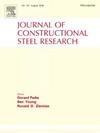Q460GJ 钢在高温下的热蠕变应变测试和模型
IF 4
2区 工程技术
Q1 CONSTRUCTION & BUILDING TECHNOLOGY
引用次数: 0
摘要
Q460GJ 钢是一种典型的高强度、高性能结构钢。在高温(400-800 °C)条件下,对两种厚度(8 毫米和 12 毫米)的 Q460GJ 钢板进行了热蠕变试验。试验结果表明,热蠕变应变随温度和应力的增加而增加。当温度超过约 500 ℃、应力比大于约 0.55 时,Q460GJ 钢板试样会产生明显的蠕变变形,因此在钢结构设计时有必要考虑钢在高温下的热蠕变变形。钢板厚度的不同不会影响 8 毫米和 12 毫米 Q460GJ 钢板在高温下的蠕变性能。当温度不超过 600 °C 时,Q460 钢的第二阶段蠕变应变率明显高于 Q460GJ 钢,而应力水平却很接近。Fields & Fields 蠕变模型适用于拟合 Q460GJ 钢的热蠕变应变时间曲线。研究结果将有助于为火灾下高性能钢结构工程设计提供理论支持。本文章由计算机程序翻译,如有差异,请以英文原文为准。
Thermal creep strain test and model of Q460GJ steel at elevated temperatures
Q460GJ steel is a typical high strength and high-performance structural steel. The thermal creep test on two thicknesses (8 mm and 12 mm) of Q460GJ steel plates at elevated temperatures (400–800 °C) was carried out. The test results showed that the thermal creep strain increases with the increases of temperature and stress. When the temperature exceeds about 500 °C and the stress ratio is greater than about 0.55, the Q460GJ steel plate specimens has obvious creep deformations, so it is necessary to consider the thermal creep deformation of steel at elevated temperatures for steel structural design. The difference in plate thickness does not affect the creep properties of the 8 mm and 12 mm Q460GJ steel plates at elevated temperatures. When the temperature is no more than 600 °C, the second stage creep strain rates of Q460 steel are obviously higher than that of Q460GJ steel while the stress levels are close. The Fields & Fields creep model is suitable for fitting the thermal creep strain-time curves for Q460GJ steel. The findings will contribute to providing theoretical support for design of high-performance steel engineering structures under fire.
求助全文
通过发布文献求助,成功后即可免费获取论文全文。
去求助
来源期刊

Journal of Constructional Steel Research
工程技术-工程:土木
CiteScore
7.90
自引率
19.50%
发文量
550
审稿时长
46 days
期刊介绍:
The Journal of Constructional Steel Research provides an international forum for the presentation and discussion of the latest developments in structural steel research and their applications. It is aimed not only at researchers but also at those likely to be most affected by research results, i.e. designers and fabricators. Original papers of a high standard dealing with all aspects of steel research including theoretical and experimental research on elements, assemblages, connection and material properties are considered for publication.
 求助内容:
求助内容: 应助结果提醒方式:
应助结果提醒方式:


